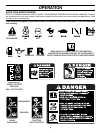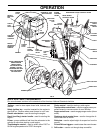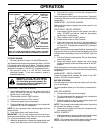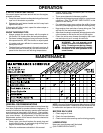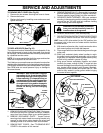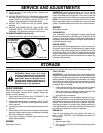
12
TO ADJUST SKID PLATES (See Fig. 18)
NOTE: The wrench provided in your parts bag may be used
to adjust the skid plates.
Skid plates are located on each side of the auger housing
and adjust the clearance between the scraper bar and the
ground surface. Adjust skid plates evenly to proper height
for current surface conditions. For removal of snow in
normal con di tions, such as a paved driveway or side walk,
place skid plates in the highest position (lowest scraper
clear ance) to give a 1/8" clearance between the scraper
bar and the ground. Use a middle position if the surface
to be cleared is uneven.
NOTE: It is not recommended to operate the snow thrower
over gravel or rocky surfaces. Objects such as gravel, rocks
or other debris, can easily be picked up and thrown by the
impeller, which can cause serious personal injury, property
dam age or damage to the snow thrower.
• If snow thrower must be operated over gravel surface,
use extra caution and be sure skid plates are adjusted
to lowest (highest scraper clear ance) position.
1. Shut off engine and wait for all moving parts to stop.
2. Adjust skid plates by loosening the rear 1/2" hex nut
only, then moving skid plate to desired position. Be sure
both plates are adjusted evenly. Tighten securely.
SKID PLATE
LOW POSITION (HIGH GROUND CLEAR ANCE)
1/2" HEX NUT
HIGH POSITION
(LOW GROUND
CLEARANCE)
AUGER
HOUSING
SCRAPER BAR
The scraper bar is not adjustable, but is reversible. After
con sid er able use it may become worn. When it has worn
almost to the edge of the housing, it can be reversed,
providing additional service before requiring replacement.
Replace a dam aged or worn scrap er bar.
FIG. 18
OPERATION
POWER STEERING OPERATION (See Fig. 17)
Steering tr iggers are used to assist in steering your snow throw-
er. The triggers are located on the underside of each handle.
When a trigger is squeezed, it disengages the drive wheel on
that side of snow thrower and allows it to turn in that direction.
• To turn left – squeeze left side trigger.
• To turn right – squeeze right side trigger.
LH TURN
TRIGGER
RH TURN
TRIGGER
FIG. 17
ADJUST-
MENT NUT
STORAGE
POSITION
AUGER
HOUSING
DRIFT
CUTTER
FIG. 19
TO USE DRIFT CUTTERS (See Fig. 19)
Use the drift cutters to cut through deep snowdrifts that are
higher than the front of the snow thrower.
• Loosen upper adjustment nut enough to allow drift
cutter to be raised to highest position and tighten nut
securely. Repeat for opposite side of snow thrower.
• When not using drift cutters, loosen adjustment nut,
lower to storage position and tighten nut securely.
BEFORE STARTING THE ENGINE
CHECK ENGINE OIL LEVEL (See Fig. 20)
The engine on your snow thrower has been shipped, from
the factory, already fi lled with oil.
1. Check engine oil with snow thrower on level ground.
2. Remove oil fi ll cap/dipstick and wipe clean, reinsert
the dipstick and screw tight, wait for a few seconds,
remove and read oil level. If necessary, add oil until
“FULL” mark on dipstick is reached. Do not overfi ll.
• To change engine oil, see “TO CHANGE ENGINE OIL”
in the Main te nance sec tion of this manual.
ADD GASOLINE (See Fig. 20)
• Fill fuel tank to bottom of tank fi ller neck. Do not over-
fi ll. Use fresh, clean, regular unleaded gasoline with
a minimum of 87 octane. Do not mix oil with gasoline.
Purchase fuel in quan ti ties that can be used within 30
days to assure fuel freshness.
WARNING: Wipe off any spilled oil or
fuel. Do not store, spill or use gasoline
near an open fl ame.
CAUTION: Alcohol blended fuels (called
gas o hol or using ethanol or methanol) can at-
tract moisture which leads to separation and
for ma tion of acids dur ing storage. Acidic gas
can damage the fuel system of an engine while
in storage. To avoid engine problems, the fuel
system should be emptied be fore stor age of
30 days or longer. Drain the gas tank, start
the engine and let it run until the fuel lines
and carburetor are empty. Use fresh fuel next
season. See Storage In struc tions for ad di tion al
information. Never use engine or car bu re tor
cleaner products in the fuel tank or per ma nent
damage may occur.







